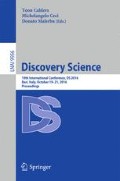Abstract
It is conventional wisdom in inductive rule learning that shorter rules should be preferred over longer rules, a principle also known as Occam’s Razor. This is typically justified with the fact that longer rules tend to be more specific and are therefore also more likely to overfit the data. In this position paper, we would like to challenge this assumption by demonstrating that variants of conventional rule learning heuristics, so-called inverted heuristics, learn longer rules that are not more specific than the shorter rules learned by conventional heuristics. Moreover, we will argue with some examples that such longer rules may in many cases be more understandable than shorter rules, again contradicting a widely held view. This is not only relevant for subgroup discovery but also for related concepts like characteristic rules, formal concept analysis, or closed itemsets.
Access this chapter
Tax calculation will be finalised at checkout
Purchases are for personal use only
Notes
- 1.
Entities should not be multiplied beyond necessity.
References
Bensusan, H.: God doesn’t always shave with Occam’s Razor - learning when and how to prune. In: Nédellec, C., Rouveirol, C. (eds.) Proceedings of the 10th European Conference on Machine Learning (ECML 1998), pp. 119–124 (1998)
Blumer, A., Ehrenfeucht, A., Haussler, D., Warmuth, M.K.: Occam’s Razor. Inf. Process. Lett. 24, 377–380 (1987)
Domingos, P.: The role of Occam’s Razor in knowledge discovery. Data Min. Knowl. Discovery 3(4), 409–425 (1999)
Fürnkranz, J.: Separate-and-conquer rule learning. Artif. Intell. Rev. 13(1), 3–54 (1999)
Fürnkranz, J., Flach, P.A.: ROC ’n’ rule learning - towards a better understanding of covering algorithms. Mach. Learn. 58(1), 39–77 (2005)
Fürnkranz, J., Gamberger, D., Lavrač, N.: Foundations of Rule Learning. Springer, Heidelberg (2012)
Gamberger, D., Lavrač, N.: Active subgroup mining: a case study in coronary heart disease risk group detection. Artif. Intell. Med. 28(1), 27–57 (2003)
Ganter, B., Wille, R.: Formal Concept Analysis - Mathematical Foundations. Springer, Heidelberg (1999)
Hall, M., Frank, E., Holmes, G., Pfahringer, B., Reutemann, P., Witten, I.H.: The weka data mining software: an update. SIGKDD Explor. 11(1), 10–18 (2009)
Janssen, F., Fürnkranz, J.: On the quest for optimal rule learning heuristics. Mach. Learn. 78(3), 343–379 (2010)
Kralj, P., Lavrač, N., Gamberger, D., Krstačić, A.: Contrast set mining through subgroup discovery applied to brain ischaemina data. In: Zhou, Z.-H., Li, H., Yang, Q. (eds.) PAKDD 2016. LNCS (LNAI), vol. 4426, pp. 579–586. Springer, Heidelberg (2007). doi:10.1007/978-3-540-71701-0_61
Kralj Novak, P., Lavrač, N., Webb, G.I.: Supervised descriptive rule discovery: a unifying survey of contrast set, emerging pattern and subgroup mining. J. Mach. Learn. Res. 10, 377–403 (2009)
Lavrač, N., Kavšek, B., Flach, P., Todorovski, L.: Subgroup discovery with CN2-SD. J. Mach. Learn. Res. 5, 153–188 (2004)
Michalski, R.S.: On the quasi-minimal solution of the general covering problem. In: Proceedings of the 5th International Symposium on Information Processing (FCIP 1969), pp. 125–128, Bled, Yugoslavia (1969)
Michalski, R.S.: A theory and methodology of inductive learning. Artif. Intell. 20(2), 111–162 (1983)
Mitchell, T.M.: The Need for Biases in Learning Generalizations. Technical report, Computer Science Department, Rutgers University, New Brunswick, MA (1980)
Murphy, P.M., Pazzani, M.J.: Exploring the decision forest: an empirical investigation of Occam’s Razor in decision tree induction. J. Artif. Intell. Res. 1, 257–275 (1994)
Paulheim, H., Fürnkranz, J.: Unsupervised generation of data mining features from linked open data. In: Proceedings of the International Conference on Web Intelligence and Semantics (WIMS 2012) (2012)
Ristoski, P., Paulheim, H.: Analyzing statistics with background knowledge from linked open data. In: Proceedings of the 1st International Workshop on Semantic Statistics (SemStats-2013). CEUR workshop proceedings, Sydney, Australia (2013)
Stecher, J., Janssen, F., Fürnkranz, J.: Separating rule refinement and rule selection heuristics in inductive rule learning. In: Calders, T., Esposito, F., Hüllermeier, E., Meo, R. (eds.) ECML PKDD 2014. LNCS (LNAI), vol. 8726, pp. 114–129. Springer, Heidelberg (2014). doi:10.1007/978-3-662-44845-8_8
Stumme, G., Taouil, R., Bastide, Y., Pasquier, N., Lakhal, L.: Computing iceberg concept lattices with Titanic. Data Knowl. Eng. 42(2), 189–222 (2002)
Webb, G.I.: Further experimental evidence against the utility of Occam’s Razor. J. Artif. Intell. Res. 4, 397–417 (1996)
Wille, R.: Restructuring lattice theory: an approach based on hierarchies of concepts. In: Rival, I. (ed.) Ordered Sets, pp. 445–470. Reidel, Dordrecht-Boston (1982)
Zaki, M.J., Hsiao, C.J.: CHARM: an efficient algorithm for closed itemset mining. In: Grossman, R.L., Han, J., Kumar, V., Mannila, H., Motwani, R. (eds.) Proceedings of the 2nd SIAM International Conference on Data Mining (SDM-02), pp. 457–473. Arlington, VA (2002)
Acknowledgements
We would like to thank Dragan Gamberger, Nada Lavrač, and Heiko Paulheim for letting us play with their data.
Author information
Authors and Affiliations
Corresponding author
Editor information
Editors and Affiliations
Rights and permissions
Copyright information
© 2016 Springer International Publishing Switzerland
About this paper
Cite this paper
Stecher, J., Janssen, F., Fürnkranz, J. (2016). Shorter Rules Are Better, Aren’t They?. In: Calders, T., Ceci, M., Malerba, D. (eds) Discovery Science. DS 2016. Lecture Notes in Computer Science(), vol 9956. Springer, Cham. https://doi.org/10.1007/978-3-319-46307-0_18
Download citation
DOI: https://doi.org/10.1007/978-3-319-46307-0_18
Published:
Publisher Name: Springer, Cham
Print ISBN: 978-3-319-46306-3
Online ISBN: 978-3-319-46307-0
eBook Packages: Computer ScienceComputer Science (R0)

